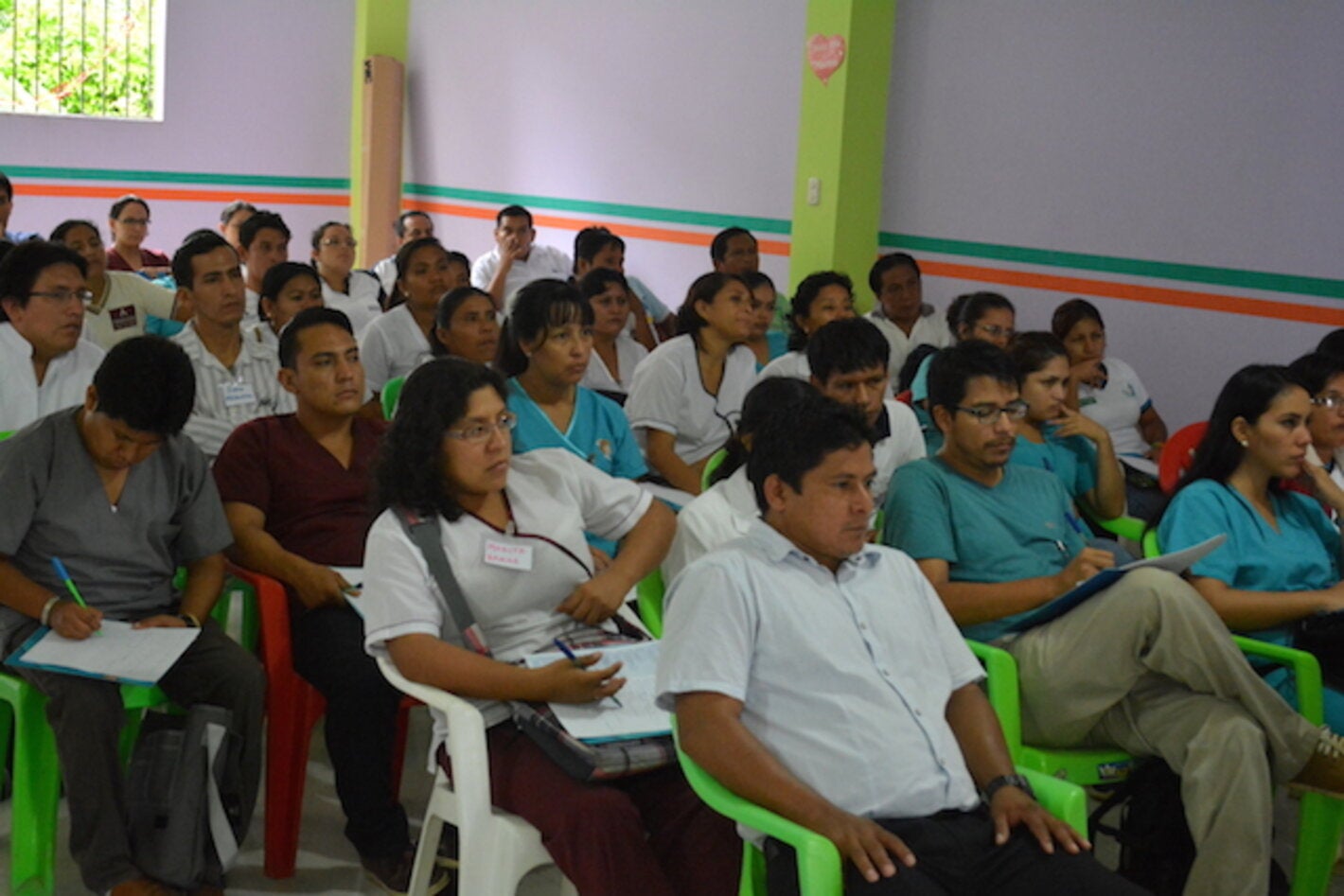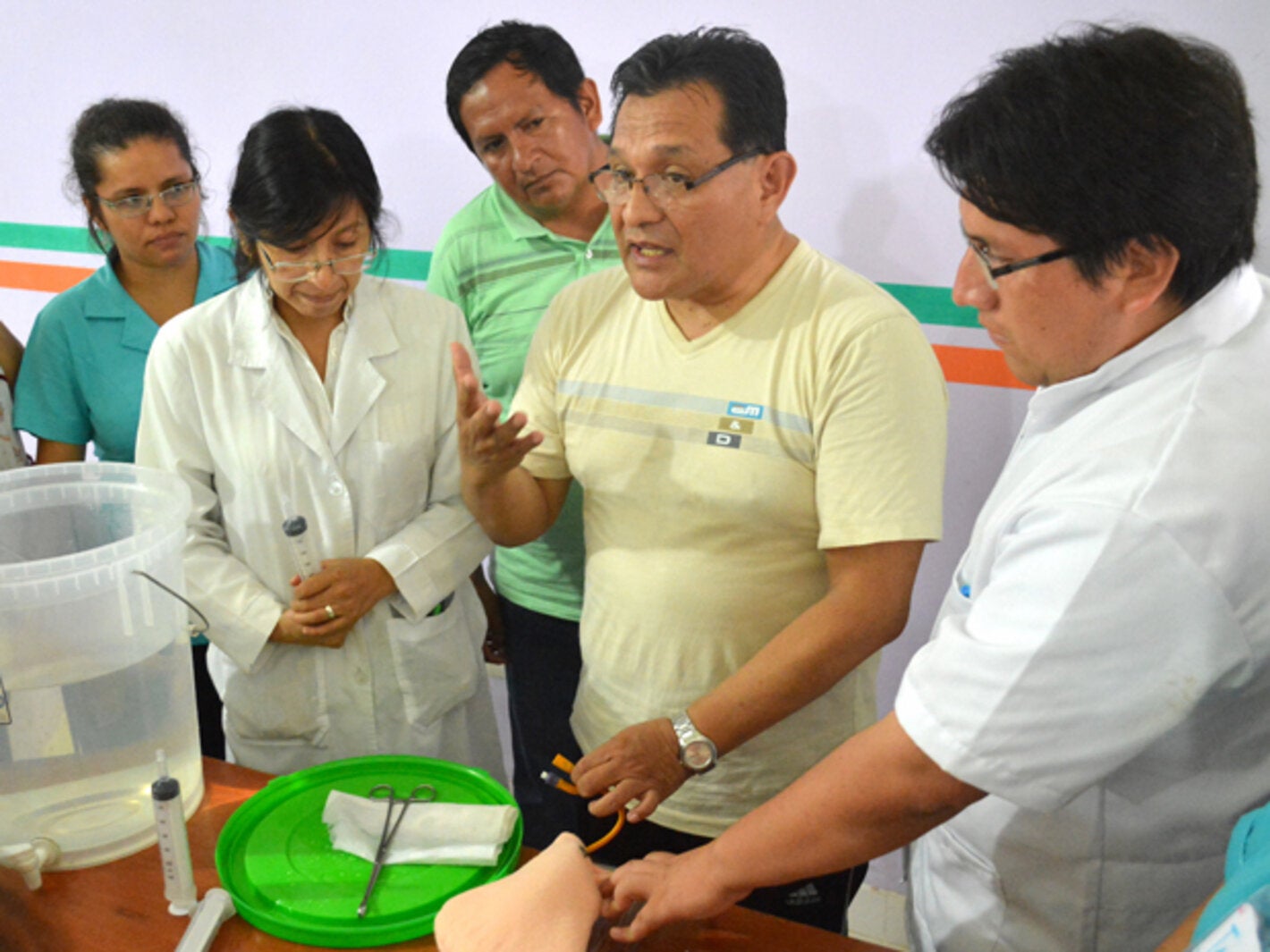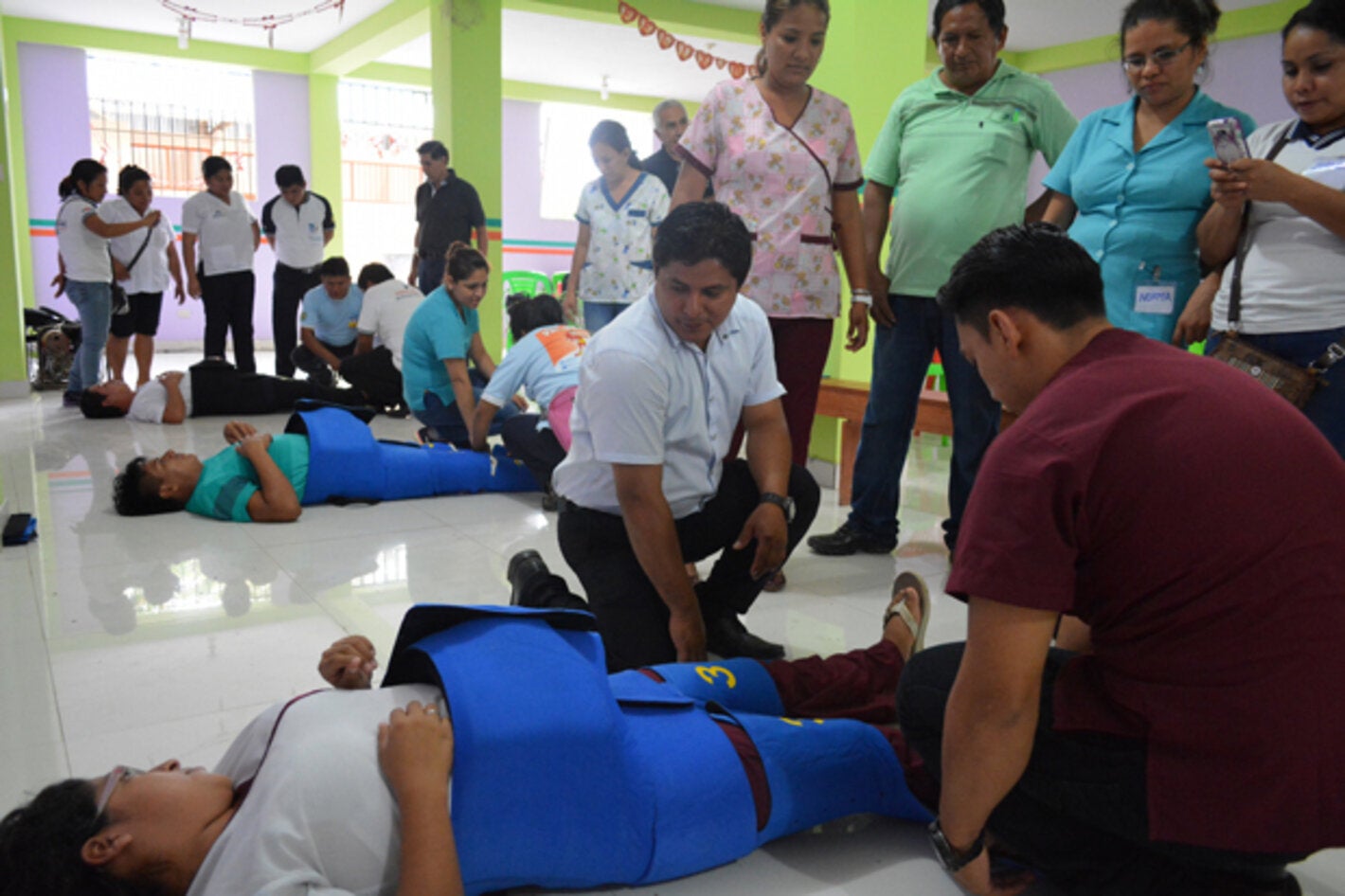
PAHO/WHO trains health professionals from seven countries in the Americas to prevent and manage obstetric hemorrhage, a leading cause of maternal death in the Region. Professionals learn to use new technologies to reduce blood loss and save lives.
Datem del Marañón, Peru, May 28 2015 (PAHO/WHO). Obstetrician Juan Chávez recounts that in San Lorenzo, Datem del Marañón Province in the Peruvian Amazon, three pregnant women lost their lives last year to the same cause: an obstetric hemorrhage. "They lived on the outskirts of town, where there are no health personnel, and they got here too late, in shock, when we could no longer do anything for them," he said regretfully.
The town of Datem, with more than 50,000 inhabitants scattered along the banks of the Marañón River, is the most ethnically diverse province in Peru and home to nearly one-third of the country's indigenous population. Indigenous women in the province have an average of 8.32 children, with the vast majority of births taking place in the home.
Chávez is one of the more than a hundred health professionals who attended training courses on emergency obstetric and neonatal management this week in San Lorenzo and the town of Saramiriza, located some four hours from San Lorenzo by boat. The courses were organized by the Pan American Health Organization/World Health Organization (PAHO/WHO), in coordination with the Datem del Marañón Health Network.
"Our aim is to strengthen and upgrade the skills of health teams to keep women from dying from obstetric hemorrhage and to improve the accessibility and quality of care — all through an intercultural approach," explained Adrián Díaz, PAHO/WHO Family, Gender, and Life Course Adviser in Peru and one of the training facilitators.
This activity was part of the Zero Maternal Deaths from Hemorrhage initiative promoted by PAHO/WHO in conjunction with the Latin American Federation of Obstetrics and Gynecology Societies (FLASOG) to reduce maternal deaths in selected areas of five countries in the Americas where hemorrhage is the leading cause.
Simple technologies that can save lives
Profuse bleeding, or hemorrhage, can leave a patient in shock and precipitate death. One of the current techniques to reduce or halt bleeding is the use of a non-pneumatic antishock garment, placed around the legs, pelvis, and abdomen of women with obstetric hemorrhage.
This garment, which the health professionals learned to place as part of their training, controls bleeding for up to 48 hours, gaining time for the patient to be transferred from a remote area or await care.
"These garments are an inexpensive, user-friendly investment that reduces the risk of death associated with maternal hemorrhage," commented Bremen de Mucio, Regional Adviser on Sexual and Reproductive Health at PAHO/WHO's Latin American Center for Perinatology (CLAP), who added, "They are a stopgap measure that can be used until the necessary care is available."
PAHO/WHO has delivered the first 4 of 50 garments to the Peruvian health authorities for distribution to each health center in Datem del Marañón. The other countries in which the project is under way have also received garments and are in the process of procuring more at a cost of approximately US$ 80 each. Having these garments, which can be used from 100 to 150 times, in health centers, ambulances, and the community could help save lives.
In addition, through simulations, the facilitators from PAHO/WHO, UNFPA, UNICEF, and Peru's Ministry of Health demonstrated how to use the intrauterine balloon, which can be inserted into the uterus to stop bleeding, and trained participants in the strategy for managing the bleeding emergency known as "obstetric code red."
The training sessions also covered aspects of family planning and neonatal health, because, as Díaz noted, "the mother-baby unit is indivisible, and both should receive the same quality of care during gestation, childbirth, and the puerperium to guarantee their good health."
Chávez, the obstetrician at San Lorenzo Hospital and manager of the Ravine Micro Health Network (Microrred de Salud Barranca), pointed out that learning "how to use the balloon and the garment was very important, because it upgraded our skills." He also remarked that for health workers to do their job properly, they need periodic training—something that does not happen very often in far-away Datem.
Health with an intercultural approach
Ethnicity, gender, and human rights were other aspects addressed during the workshop in Peru and the other countries.
In Saramiriza, PAHO/WHO personnel spoke with traditional midwives to learn their perceptions and opinions about the introduction of these new technologies. "As in all cases," noted Díaz, "successful implementation of this new tool will depend on its acceptance by the local community, and that requires an appropriate dialogue that respects its world view."
Training trainers
Bolivia was one of the first of the five countries involved in the Zero Maternal Deaths from Hemorrhage initiative to hold a simulation workshop on obstetric hemorrhage to upgrade the skills of health professionals, selecting the department of El Alto for the implementation of the project.
These professionals will be responsible for training others to increase familiarity with a series of techniques that can reduce the risk of maternal death. In El Alto, postpartum hemorrhage is considered the leading cause, killing three out of ten pregnant or post partum women.
In mid-March, the same training was held in the Dominican Republic for health workers at the José María Cabral y Báez, los Mina, Altagracia, and Health Region VII hospitals. The participants included officials from the Ministry of Health's General Directorate of Maternal and Child and Adolescent Health (DIGEMIA).
Haiti went down a similar road in April, with a workshop to train trainers in the management of obstetric hemorrhage. A group of 15 physicians, nurses, and midwives from 10 hospitals and health centers in the country's Sud department were trained.
The training workshop was also held in Guatemala's Izabal department, where a work plan to reduce maternal deaths from hemorrhage is being drafted.
Other workshops are expected to be held in these countries to improve the quality of care and add to the tools available to health workers to prevent women from dying from hemorrhage.
Through this project and other interventions, PAHO/WHO and the countries of the Region are working to hasten progress in reducing maternal mortality in the Americas. The goal is to reduce regional maternal mortality by at least 11% over 2014 levels by the year 2019.
Links
Bolivia
- "Zero maternal deaths by hemorrhage" moves forward in El Alto, Bolivia
- Preventing maternal deaths after childbirth in Bolivia
- Video: Cero muertes maternas por hemorragia en El Alto, Bolivia [in Spanish]
Dominican Republic
- Cero Muerte Materna por Hemorragia, El derecho a la salud materna, acceso a servicios oportunos y de calidad [in Spanish]
Guatemala
- Izabal implementará iniciativa cero muertes maternas por hemorragia [in Spanish]
- Zero Maternal Deaths by Hemorrhage: health authorities from several countries in the Region took the challenge
Haiti
Nicaragua





